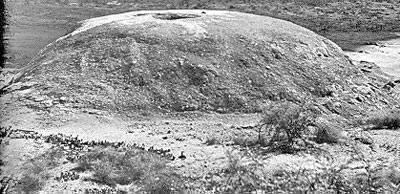In the beginning the wide Underworld beneath the present world
was one vast
sea, the Hopi have told their descendants down through the ages.
Far to the
east and to the west lived two female deities-the owners of such precious
things as seashells, coral, and turquoise.
Each of these Hurung Whuti, as
the Hopi called them, lived in a house similar to a kiva in the Hopi village
of today.
The Hurung Whuti of the East had one gray and one yellow fox skin
tied to the top of the high ladder which led down into her kiva-like house,
while that of the deity of the West had a large turtle-shell rattle.
Every day Sun dressed for the early morning in the gray fox skin, and for
the full day he donned the skin of the yellow fox.
He rose from the north
end of the kiva of the Hurung Whuti of the East, slowly passed over the
waters of the Underworld, and, after touching the turtle-shell rattle on her
ladder, he descended into the kiva of the Hurung Whuti of the West.
Eventually the two Hurung Whuti decided there should be some dry land in the
Underworld, and parted the waters so that land appeared.
But Sun could
discover no sign of life upon it and he reported this to the Hurung Whuti of
the East, who journeyed over a great rainbow to confer with her sister of
the West.
After a long council they decided that they would create life.
They took clay and fashioned a small wren. Placing a piece of cloth over the
wren, they sang certain songs which imparted life to it.
Then they instructed Wren to fly here, there, and everywhere over their
newly created land to see if it could find any signs of other life. Wren
failed to see Spider Woman, the deity of the earth, who lived in her
kiva
home away to the southwest-so he reported that the whole land was barren.
Thereupon, the Hurung Whuti of the West created many birds and animals in
the same way as the wren had been created.
She sent them out to inhabit the
earth. As her sister had created the birds and the animals, the Hurung Whuti
of the East created a man and woman out of the same kind of clay and covered
them with the same cloth.
Again the Hurung Whuti sang their special songs,
and the man and the woman were endowed with life.
The two Hurung Whuti
taught the man and the woman a language, and the deity of the East led them
back over the rainbow to her home. There they lived for a short time before
they and their children wandered out over the eastern land to make homes of
their own.
While the Hurung Whuti were busy creating the birds, the animals, and the
first man and woman, Spider Woman decided that she, too, would create men
and women.
Thereupon she gave life to all kinds of people, and with the help
of Mockingbird (Yaupa) taught each group its own language before sending it
off to live throughout the Underworld.
After a council with her sister, the
Hurung Whuti of the West decided that
she must create more people to inhabit the lands of the West. These were the
ancestors of the Hopi.
After this was accomplished the Hurung Whuti parted
and went to live for all time in their homes under the waters far to the
East and far to the West.
The Hopi still remember the Hurung Whuti and make many prayer offerings to
them.
Turquoise, seashells, and coral still serve the Hopi as sacred
reminders of those beneficent deities of creation.


